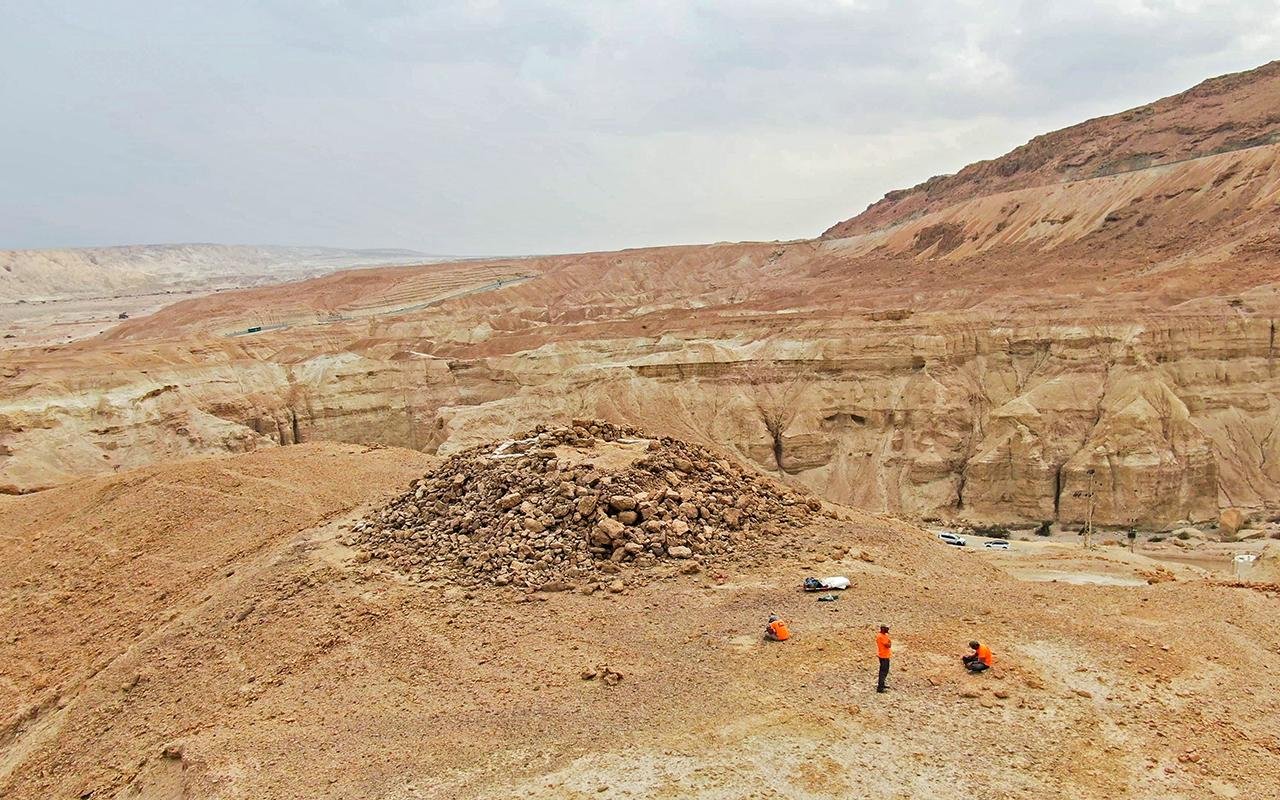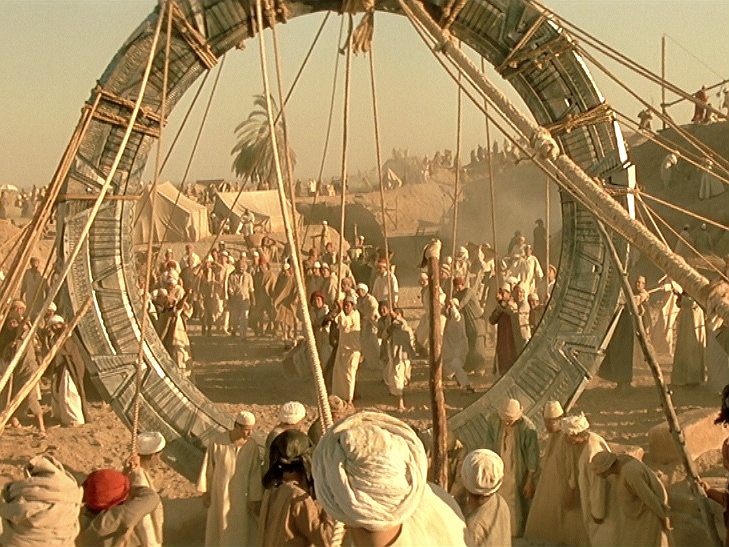 Reseachers uncover a pyramid-like structure in the Judean Desert, photo taken March 2025 (photo credit: JUDEAN DESERT SURVEY UNIT, ISRAEL ANTIQUITIES AUTHORITY)
Reseachers uncover a pyramid-like structure in the Judean Desert, photo taken March 2025 (photo credit: JUDEAN DESERT SURVEY UNIT, ISRAEL ANTIQUITIES AUTHORITY) Posted on 03/26/2025 6:03:53 PM PDT by Red Badger

===============================================================================
Experts uncover a massive pyramid-shaped structure, ancient papyrus documents and rare artifacts from Hellenistic-era rule in southern Israel, shedding new light on the region’s history.
An excavation in the Judean Desert unearthed a massive 2,200-year-old pyramid-shaped structure alongside ancient papyri, weapons, tools, and fabrics, which experts are calling one of the richest archaeological excavations in the area.
The Israel Antiquities Authority and the Heritage Ministry, which are jointly leading the dig north of Nahal Zohar, say the findings date to the Hellenistic period, when the Ptolemies and Seleucids ruled the Land of Israel.
Watch the Judean Desert discoveries video below:
VIDEO AT LINK..................
The project, now open to public volunteers, is part of a broader eight-year effort to rescue endangered antiquities in the region from looters and natural degradation.
“This pyramidal structure we discovered is huge and made of hand-hewn stones, each weighing hundreds of kilograms,” said IAA excavation directors Matan Toledano, Eitan Klein, and Amir Ganor.
“Already in the first excavation week, the volunteers found written historical documents, exceptional bronze vessels, and remains of ancient furniture, which, thanks to the desert climate, were preserved in amazing condition,” they said.
Coins of Antiochus Epiphanes IV found in the excavation in the Judean Desert, Israel, March 2025 (credit: JUDEAN DESERT SURVEY UNIT, ISRAEL ANTIQUITIES AUTHORITY)
==========================================================================================
The excavation directors said the discovery had changed Israel’s historical record.
Among the artifacts recovered so far are Greek papyrus scrolls, bronze coins bearing the faces of Ptolemaic rulers and Antiochus IV, and wooden tools. The structure sits above what appears to be an ancient way station, possibly used along a trade route moving salt and bitumen from the Dead Sea to Mediterranean ports.
The Judean Desert project
The site had previously been assumed to date back to the First Temple period, but current findings suggest it was built centuries later, raising new questions about its original purpose.
“Is this a guard tower for a major commercial route? A monumental grave or ceremonial landmark?” the directors wondered. “It is an enthralling historical mystery – and to our delight, the public coming to volunteer in the excavation are our partners in uncovering the answers.”
The Nahal Zohar dig is part of a sweeping Judean Desert project led by the IAA’s Robbery Prevention Unit, which has surveyed 180 km. of cliffs and identified roughly 900 caves. The operation has uncovered thousands of rare items in recent years – including ancient scrolls, weapons, leather goods, and coins – often using rope access, drones, and cutting-edge documentation tools.
An ancient papyrus found in the excavation in the Judean Desert, Israel, March 2025 (credit: JUDEAN DESERT SURVEY UNIT, ISRAEL ANTIQUITIES AUTHORITY)
=====================================================================================
“The discoveries are exciting and even emotional, and their significance for archaeological and historical research is enormous,” said Eli Escusido, the IAA’s director.
“Right now, just before Passover and with the onset of spring, I invite the people of Israel to come and participate! In such a challenging time, a few days of discovery in the Judean Desert offer a connective and uplifting experience for everyone,” he said.
The excavation is expected to continue for another three weeks, with volunteers invited to join the effort. An organized camp has been set up to accommodate participants, complete with meals, water, and nightly archaeology lectures.
PinGGG!!!!!.........................
MORE INFO:
https://paleojudaica.blogspot.com/2025/03/more-on-pyramid-and-scroll-finds-at.html
More on the pyramid and scroll finds at Nahal Zohar
ARCHAEOLOGY AND EPIGRAPHY UPDATE:
Enigmatic 2,200-year-old ‘pyramid’ near Dead Sea may have been fortress for ancient taxman. Excavations by Israeli archaeologists at the mysterious Judean Desert site reveal artifacts suggesting it served as a post for tax collection and later, a Roman-era tomb (Rosella Tercatin, Times of Israel).
This article on the recently announced discoveries at the Nahal Zohar excavation covers the earlier information and also interviews excavator Dr. Eitan Klein. It has some new thoughts about what the pyramid was for:
“The heap is five or six meters high above the surface of the hill, made of huge stones,” Dr. Eitan Klein told The Times of Israel over a phone interview. “We immediately noticed that someone had dug at the top of the structure, probably looters who had identified the grave.”
“At first, we thought the site could be just a tomb, but later, we noticed the shape of the original walls, and we understood that the structure was a building,” he added. “Eventually, we identified it as a tower or fortress dating back to the Hellenistic period, or 2,200 years ago.” ...
“We know that the main road linking Edom — modern-day Jordan — to Gaza passed directly beneath our structure,” said Klein, co-director of the excavation for the IAA alongside Matan Toledano and Amir Ganor. “We believe the building served to safeguard the road and may have been used by Ptolemaic officials to collect taxes from travelers.”
And more on the scroll fragments:
Although looters reached it first, archaeologists still managed to recover a wealth of organic and inorganic findings, such as papyri fragments inscribed in Greek, wooden tools and fabrics.
While additional research is required to decipher the content of the papyri, Klein said that they might have been part of tax documents.
I don’t know if that is based on already deciphered content or just on the suggested purpose of the building.
There is also more discussion of the coin finds.


Built to collect tariffs, some things never change.
Death and TAXES................
Why hasn’t every square foot of the country been mapped and explored by now?
 Excavation by the Israel Antiquities Authority and volunteers, north of Nahal Zohar (Photo: Emil Aladjem, Israel Antiquities Authority)
Excavation by the Israel Antiquities Authority and volunteers, north of Nahal Zohar (Photo: Emil Aladjem, Israel Antiquities Authority)
Why are these artifacts always found in places that look like this?
Because if it looked like people lived there - we’d never find them.
This was most likely a military outpost. look at the views from post 9...............
For thousands of years, that big pile of rocks on a hill was a land mark but no one knew why.
We have a local landmark here, called “The Indian Temple Mound”.
It’s a big pile of dirt...............
My very unprofessional opinion is that it is because people “see” what is in front of them and mostly take it for granted that it has always looked the same. Few people look and think what is 50 ft or 100 ft below what I see? Floods and cataclysms and regular weather over centuries all combine to bury the past. I do agree that the relatively small area should be much more explored and “known”
Thanks for your ping, Mike!
So very many caves in Israel, full of Dead Sea Scrolls and all sorts of odds-and-ends. As the angels watched God fashion all those caves through all those eons, my guess is not one of them ever even imagined the exalted purpose He had in mind for them.
Those must be the caves Lot and his daughters fled to ..........
Those were the famous Hanky-Panky Caves, where the motto was “What Daddy doesn’t know won’t hurt him.”
Sacred dirt....
BTTT
Disclaimer: Opinions posted on Free Republic are those of the individual posters and do not necessarily represent the opinion of Free Republic or its management. All materials posted herein are protected by copyright law and the exemption for fair use of copyrighted works.